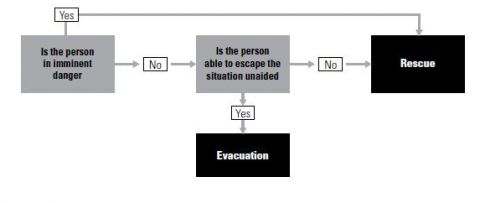Emergency Response – Why SpanSet can help you find a solution?
If you have selected a method of working that could result in a worker being suspended in a harness, for example fall arrest, or work positioning techniques, then you must consider the rescue implications.
Rescue for personnel suspended at height is an issue that needs addressing for workers, whether they are at 2m or 200m. Traditionally a great deal of emphasis has been placed on this area by those working in extreme environments and quite rightly so. It also applies however to areas that appear more straightforward, but in these areas it is seldom addressed.
Unconsciousness or death can occur to a suspended casualty even though they may not be injured after their initial fall. This is due to a decrease in the effective circulation of oxygenated blood around the body caused by a combination of factors, such as body position, compression by the harness and a lack of muscle pumping of venous blood.
If the worker is able to move, or relieve the pressure points, then the side effects can be dramatically reduced. However in the case of an unconscious worker the side effects continue unchecked and rescue is the only option. The time it takes for this condition to affect a person can vary greatly, so having an effective solution at hand for a speedy resolution is essential.
There are several approaches to rescue provision, 1st Response Rescue, Emergency Response Teams and the Emergency Services, each approach having it’s own merits and disadvantages. The rescue equipment can also take many different forms all with different levels of risk, training requirements, aptitude and commitment.
It is therefore important to identify the solution that is right for your application. In order to do this you must consider all the variables such as the equipment they are using, where they are using it and the capability of the users. The GOTCHA™ Rescue Range has been designed to provide simple pre-assembled solutions for a variety of applications.
Another aspect of emergency planning that can be confused with Rescue is Evactuation.
A useful definition between Rescue and Evacuation is:

Choosing the right rescue solution for your workers
1st Response Rescue
- Available as an on-site rescue solution
- Immediate response
- Often application specific
- Can be carried out safely by a fellow worker or supported by the Emergency Services
- Requires a commitment from fellow workers
- Workers require training and refresher opportunities for it to be effective
This is a great solution for short term tasks or for contractors who need to provide a self contained solution for work at height.
Emergency Response Teams
- Available as an on-site rescue solution
- Fast response
- Should cover all issues on the specific site
- Carried out safely by staff selected and trained for the purposes identified
- Able to work alongside the Emergency Services
- Requires a commitment from the site to set up a team and maintain its currency
- Requires constant appraisal to ensure new work tasks can be covered
This can be an expensive option, however larger sites may prefer this option as the team are able to cover many different work areas or tasks.
Emergency Services
- Equipped to cope with a wide range of situations
- Professional personnel
- Skills and knowledge regularly refreshed
- Should not be considered as a first response solution for work at height
- Availability cannot be controlled by the site
- Response times will vary depending upon external factors
- Site specific issues may only be possible with consultation
The Emergency Services provide an excellent service, but are only able to address issues that they are aware and trained to perform. This is an option that many workers rely upon without actually checking that the service is capable of meeting their expectations.
1. Casualty
What we know: -
- They are suspended from an anchor point
- They are wearing a full body harness
- They are at risk from the effects of suspension
- Whilst suspended it is virtually impossible to provide even basic first aid
2. Rescuer
What is required: -
- They must address their own safety first
- They must be able to act calmly and effectively
- They must have regular practice in the techniques for rescue
- They should reassure the casualty
3. Equipment
What is required: -
- It must recover the casualty to a point of safety with minimal risk to the casualty or rescuer
- It must be simple to operate
- It must be designed for the job it is being asked to perform
Click here to view the range